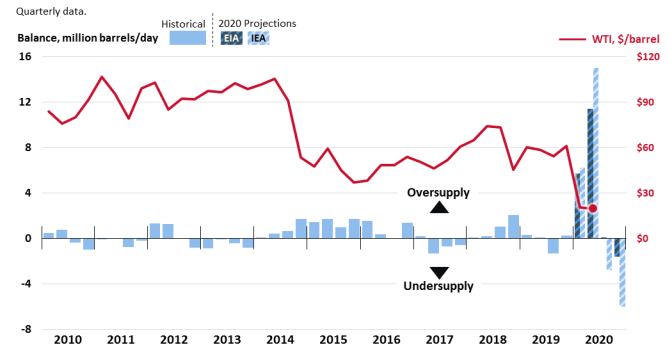Low Oil Prices: Prospects for Global Oil Market Balance
Reduced travel, slowing economic activity, and petroleum-product demand suppression related to the COVID-19 outbreak, combined with announced plans to increase crude oil supplies, created expectations of an imbalanced and significantly oversupplied near-term petroleum market. Oversupply expectations have contributed to oil prices declining nearly 60% since January. Some regional oil prices have been less than $10 per barrel. While low oil prices are generally positive for consumers, current price levels are causing financial stress for the U.S. oil sector and several policy options could be explored that might provide some degree of relief.
Market balance—supply minus demand—is one important factor that influences oil prices, refinery crude oil acquisition cost, and the price of consumer petroleum products (e.g., gasoline). Oil market characteristics—generally inelastic supply and demand in the short term—can contribute to market conditions that could result in volatile price movements (both up and down) when supply and demand are imbalanced by 1 to 2 million barrels per day (Mbpd) for a brief or extended period. Preliminary projections—subject to revision—indicate that global imbalance could be as high as 15 Mbpd in the second quarter (2Q) of 2020 (see Figure 1), including the Organization of the Petroleum Exporting Countries (OPEC) crude oil production agreement (see details below) that takes effect in May. Prolonged oversupply periods at this level could test petroleum storage and logistical limits and could further depress oil prices. However, current projections—that include uncertain assumptions about demand recovery—indicate that balance could move to an undersupplied state as early as 3Q2020.
Market Balancing Options
Balancing petroleum markets during normal periods of economic activity is challenging due to demand uncertainties, unplanned supply outages, and geopolitical events. Generally, OPEC production decisions aim to manage oil supply in order to achieve its stated mission to stabilize markets. Since 2017, OPEC and a group of non-OPEC countries (collectively OPEC+), including Russia, have engaged in agreements to adjust production. Current oversupply expectations are primarily the result of demand suppression related to COVID-19.
Market balance in the short-term would largely depend on economic activity returning to pre-outbreak levels, the timeframe for which is uncertain as actual demand impacts are unknown. Addressing the supply side of estimated market imbalances could take the form of price-responsive adjustments, an OPEC+ production agreement, or some sort of government intervention.
Price-Responsive Supply Adjustments
Current market and price conditions create challenges for all oil companies and oil-producing countries, including the U.S. oil sector. In the short-term, oil supply could be reduced by decreasing production from existing assets should price levels decline below marginal production costs. Efforts to manage financial impacts are reportedly happening at the company (e.g., capital expenditure reductions and employment adjustments) and country (e.g., budget and spending reductions) level. Reports indicate that U.S. drilling activity is declining, and EIA projects U.S. crude oil production in 2020 will be 500,000 bpd lower than 2019. While price-responsive adjustments could motivate efficiency within the oil sector, such an approach—due to the uncertain timeframe for demand and price recovery—could also have long-term adverse effects on some companies and the locations in which they operate.
OPEC+ Production Agreement
After failing to agree on an OPEC recommendation to further reduce oil production through 2020, OPEC+ subsequently announced an oil production agreement with the intent of stabilizing the oil market. Using October 2018 production levels as a baseline for most countries (Saudi Arabia and Russia are baselined at 11 Mbpd), the agreement would collectively reduce crude oil production by different amounts over various periods:
- May 1-June 30, 2020: 9.7 Mbpd
- July 1-December 31, 2020: 7.7 Mbpd
- January 1, 2021-April 30, 2022: 5.8 Mbpd
The agreement also calls on non-OPEC+ oil producers to contribute to market stabilization.
Government Supply Intervention
Among countries outside of the OPEC+ group, some governments have intervened to manage production levels. These efforts have generally aimed to address domestic or regional market imbalances. For example, the government of Alberta, Canada, has an active oil production limit program. Instituted in December 2018, the curtailment policy aims to match production volumes with transportation—pipeline and rail—capacity in order to support regional prices that influence producer revenues and provincial royalties.
On April 10, 2020, energy ministers from G20 countries held a virtual meeting to discuss energy market stability and possible actions that might address energy sector issues. The meeting communique stated that the group was committing "to take all the necessary and immediate measures to ensure energy market stability." To date, with the exception of Saudi Arabia, Russia, and Mexico—each party to the OPEC+ agreement—there have been no quantitative oil production commitments at the group or country level that would contribute towards addressing near-term market oversupply.
Historically, the U.S. federal government and some oil-producing states have engaged in efforts to curtail oil supply. Regulatory agencies in Oklahoma, Texas, Louisiana, and other states have prorationed—similar to quotas—oil supply within their respective jurisdictions. Those efforts, which are generally based on conservation and waste prevention authorities, essentially ended in the early 1970s as domestic demand exceeded domestic production. However, efforts are underway to consider reinstituting these state-level authorities. The Railroad Commission (RRC) of Texas held an open meeting—in response to a filed complaint—to discuss many different stakeholder views about prorationing oil production in the state. A similar appeal has been submitted to the Oklahoma Corporation Commission (OCC) and a hearing is reportedly scheduled for May 11, 2020.
Oil curtailment efforts at the federal level have generally been limited to prohibiting interstate transportation of oil volumes that exceed state production limits ("contraband oil"), an existing Presidential authority (15 U.S.C. §715).
